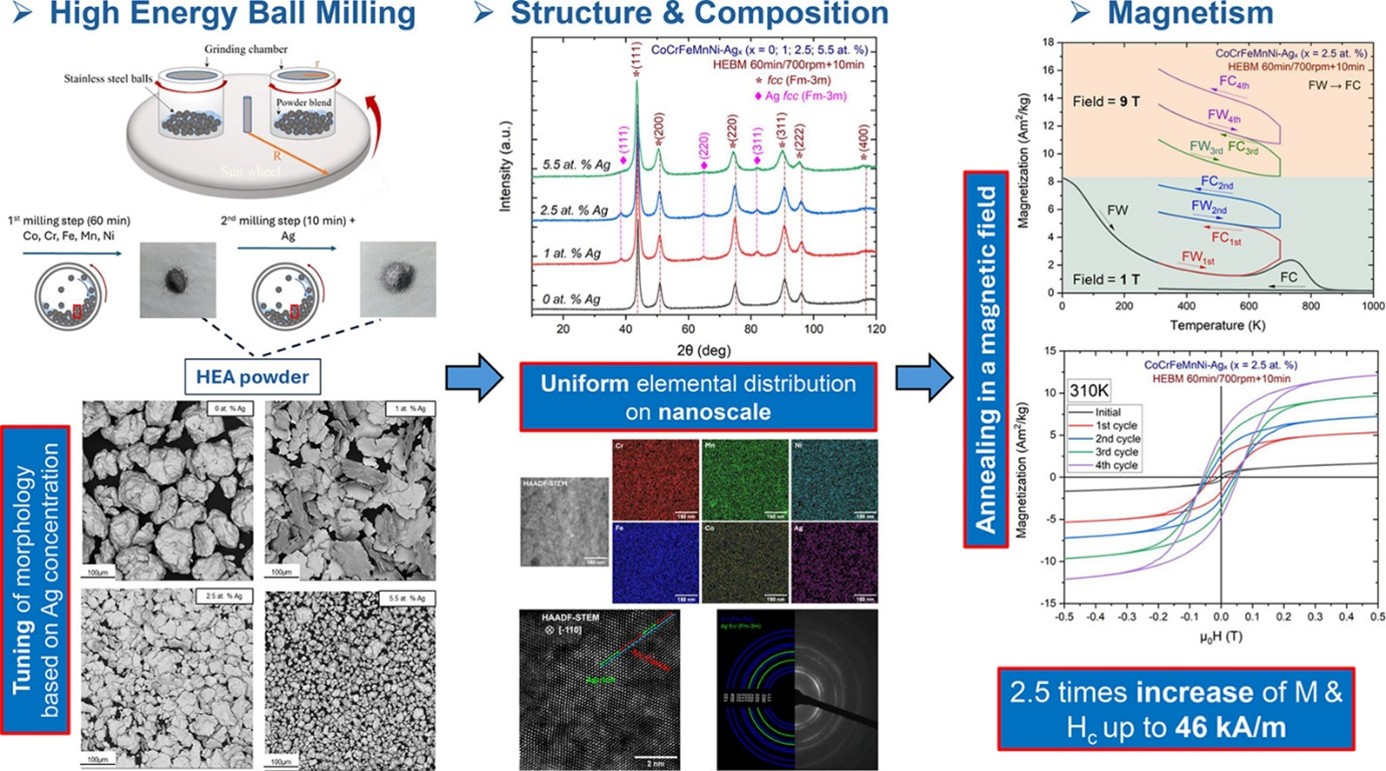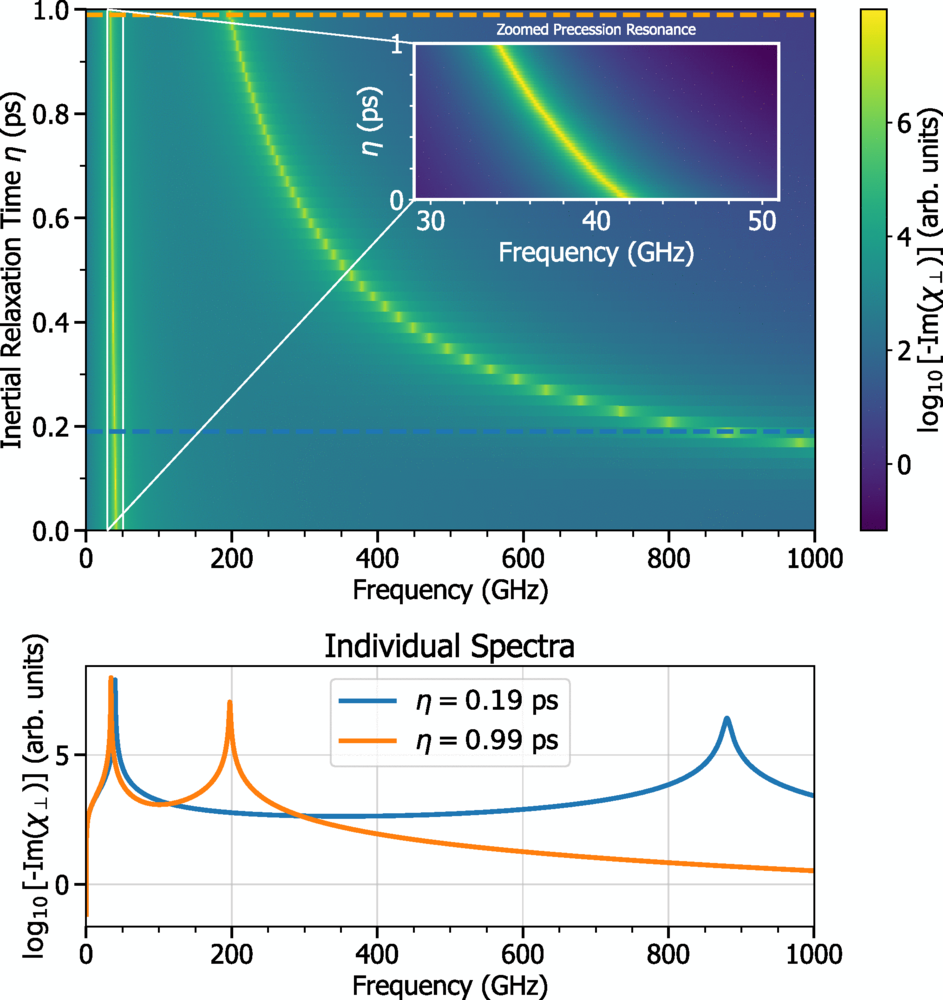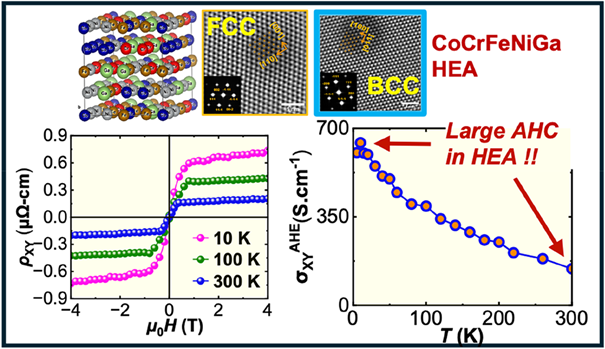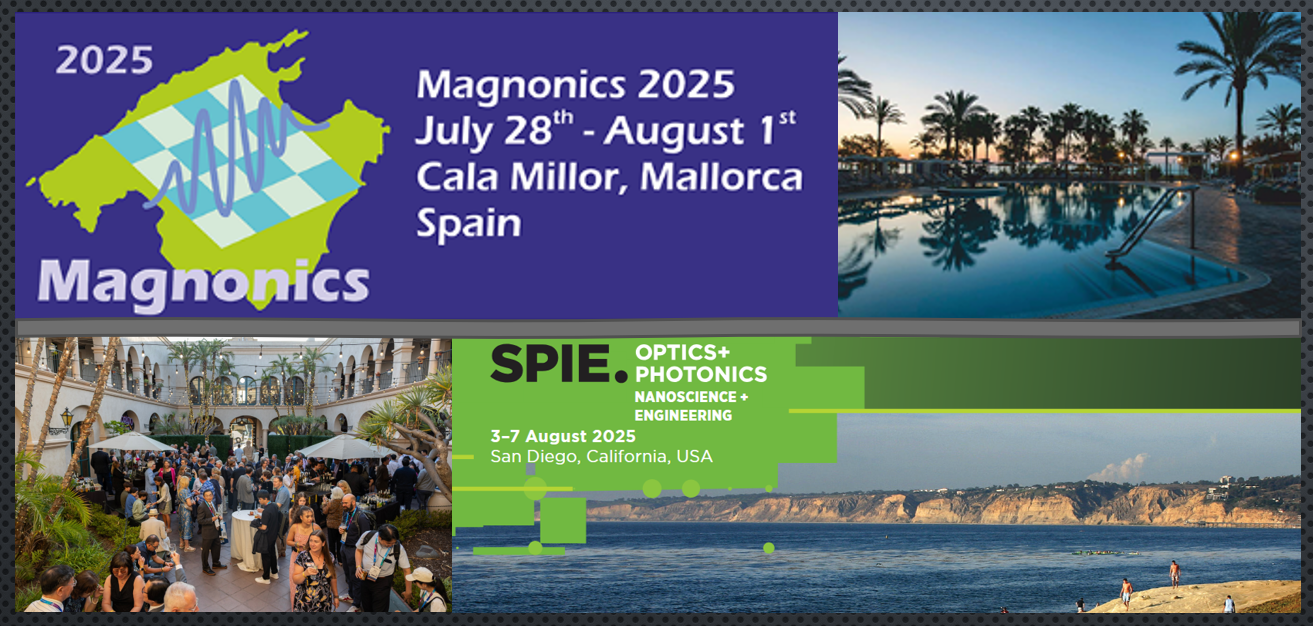|
2025-11-21: New publication in Acta Materialia: Tailoring structure, morphology, composition, and magnetism by Ag addition to CoCrFeMnNi–Agx (x = 0; 1; 2.5; 5.5 at. %) high-entropy alloy powders prepared by high-energy ball milling

|
We have successfully synthesized nanocrystalline high-entropy alloy (HEA) powders for the first time through a rapid, two-step high-energy ball-milling (HEBM) process in Ar. A single-phase fcc Cantor alloy with uniform elemental distribution was obtained after just 60 min of HEBM from an elemental powder blend. Subsequent HEBM for 10 min with Ag addition enabled precise control over Ag distribution and particle morphology, which evolved from flake-like structures with Ag-rich edges (x = 1; 2.5 at. %) to homogeneous spherical particles (x = 5.5 at. %). All compositions exhibit paramagnetic behavior at 310 K, with Curie temperatures (Tc) decreasing from 96 K (Ag-free CoCrFeMnNi) to 71 K (Ag = 5.5 at. %), indicating suppression of magnetic ordering. Importantly, annealing up to 710 K in a magnetic field significantly enhances the magnetic response across all compositions. The CoCrFeMnNi–Agx (x = 2.5 at. %) HEA shows the most pronounced improvement, with magnetization (M) (9 T, 310 K) increasing 2.5-fold to 16 Am2/kg, coercivity (Hc) reaching 46 kA/m, and remanence of 4.8 Am2/kg. Notably, M approaches ∼ 1/3 of pure Ni under the same conditions, while exhibiting a Hc nearly two orders of magnitude higher.
These results highlight that Ag alloying and thermal treatment offer an effective approach to tuning magnetic properties in CoCrFeMnNi-based HEAs without compromising structural integrity. The ability to tailor structure, morphology, and magnetism through a scalable route promotes Ag-doped Cantor alloys as promising candidates for multifunctional applications requiring combined structural and magnetic performance.
https://doi.org/10.1016/j.actamat.2025.121717
|
|
2025-11-04: Iron-cementite (Fe-Fe3C) "core-shell" magnetic nanoparticles
In a German, United states, Russian and Armenian collaboration 20 nm sized particles embedded in a carbon matrix were synthesized via solid-state pyrolysis of ferrocene and structurally and magnetically characterized. The efficacy of magnetic hyperthermia as a function of nanoparticle concentration, as well as the frequency and amplitude of the alternating magnetic field, was systematically investigated. A numerical model simulating a single nanoparticle embedded in a fluid enabled the determination of the critical concentration in suspensions, beyond which the assumption of non-interacting particles no longer holds. For further details see
https://doi.org/10.1016/j.nxmate.2025.101398 |
2025-10-05: New publication: Tunable Magnetic Remanence of Antiferromagnetically Coupled Fe3O4@SiO2 Nanoparticles for In Vivo Biomedical Applications
In our recent publication "Tunable Magnetic Remanence of Antiferromagnetically Coupled Fe3O4@SiO2 Nanoparticles for In Vivo Biomedical Applications" together with the group of V. Salguerino (U. Vigo, Spain) we investigated the complex switching behavior of two ferromagnetic half-ellipsoids separated by a paramagnetic grain boundary. These particles provide an avenue for biomedical applications in hyperthermia or magneto-mechanic cell destruction. Furthermore, they serve as a prototype study for the magnetic response of two ferromagnetic grains acted on by magnetic fields of different orientation and strengths in a permanent magnet. Our study combining experimental 3D magnetic contrast (Transmission electron Microscopy) and micromagnetic simulations (µMax3) provides quantitative calculations and experimental observations of the remanent magnetization dependent on the sequence of applied magnetic fields -allowing to set a zero or maximum remanent magnetic state of the two grains non-invasively.
https://doi.org/10.1021/acsanm.5c02458 |
2025-09-19: New publication: New Theoretical Framework Sheds Light on High-frequency Magnetic Phenomena Driven by Inertia

|
Our research group has developed a new theoretical model that offers a deeper understanding of how magnetic materials behave at extremely high frequencies. Published in the APS journal Physical Review B, our work explains how inertial effects influence the magnetic resonance response of ferromagnets.
Previous models for microwave spectroscopy reached their limits when frequencies became so high that the inertia of magnetic moments came into play. This inertia causes the magnetization to show a delayed response to an applied magnetic field, much like a spinning top that wobbles (nutation) after a nudge before settling back into a stable rotation.
The new framework provides a comprehensive mathematical solution to quantitatively predict these effects. It yields the complete tensor of the magnetic susceptibility, a measure of how a material responds to an external magnetic field. Crucially, our model accounts for both the primary oscillation (precession) of the magnetisation and the subtle, high-frequency nutation that occurs in the terahertz range for continuous microwave excitation.
These findings are particularly relevant for magnonics, a field that uses spin waves to transmit and process information. By paving the way for new magnonic components operating in the terahertz range, this research could be the foundation for the next generation of ultra-fast, energy-efficient data processing.
https://doi.org/10.1103/dhk6-78tt
|
|
2025-09-04: New CRC/TRR 270 HoMMage Publication: Nanocrystalline Room-Temperature Ferromagnetic CoCrFeNiGa High-Entropy Alloy with Potential Breakthrough for Spintronic Devices

|
We are delighted to announce our recent publication in ACS Nano in collaboration with Prof. Hari Srikanth and his group at the University of South Florida.
In this work, we report on nanocrystalline CoCrFeNiGa, a room-temperature bulk magnetic high-entropy alloy (HEA) based on 3d transition metals. The alloy exhibits mixed BCC–FCC phases with ~51 nm crystallites, a high Curie temperature of ~872 K, soft magnetic behavior, and spin freezing below 60 K.
Most notably, CoCrFeNiGa demonstrates a large intrinsic anomalous Hall effect (AHE) — ~603 S⋅cm-1 at 5 K and ~144 S⋅cm-1 at 300 K — making it highly promising for next-generation spintronic devices.
This study highlights nanocrystalline magnetic HEAs as robust candidates for applications under demanding conditions, opening exciting avenues for spintronic architectures.
For details see here
|
|
2025-08-08: Invited talks at Magnonics 2025 (Spain) and Spintronics XVIII (SPIE Optics + Photonics 2025, USA)

|
Our group members gave invited talks at international conferences Magnonics 2025, Spain (Anna Semisalova) and Spintronics XVIII, SPIE Optics + Photonics, Nanoscience + Engineering Symposium, USA (Jonas Wiemeler). |
|





